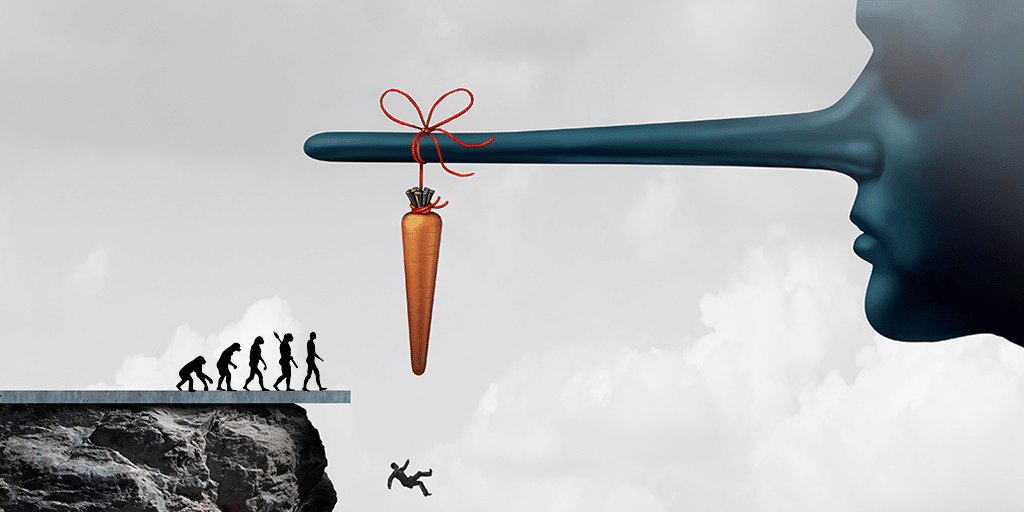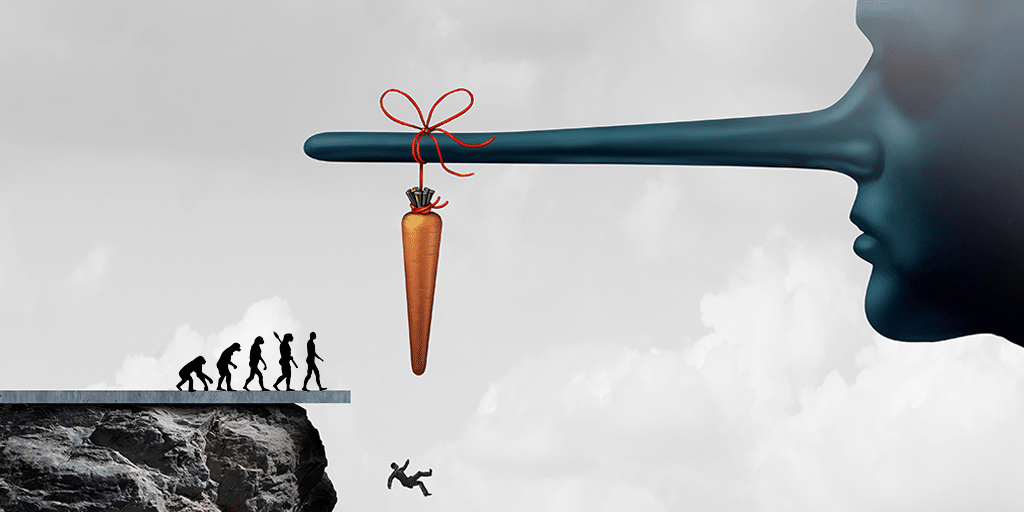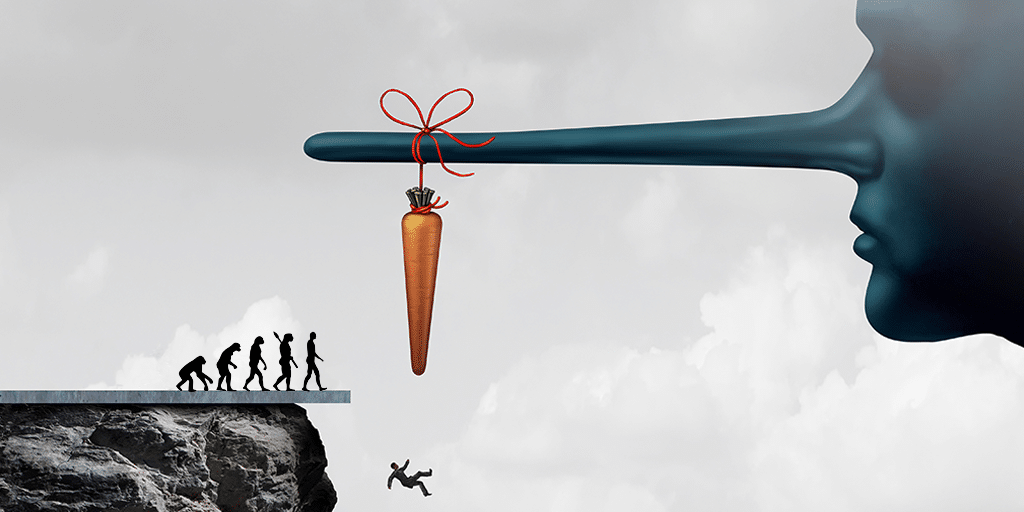Does the Fossil Record Prove that Evolution is True? – Part 2

| By: Dr. John Ankerberg and Dr. John Weldon; ©1999 |
| The fourth false assumption is that there is credible evidence in the fossil record to support the evolutionary theory. Drs. Ankerberg and Weldon quote well-known scientists who show that that is simply not the case. |
False Assumption Four: The fossil record offers genuine scientific evidence that evolution is true.
(continued from last week’s article)
In “The Nature of the Fossil” record, Ager also points out what every informed scientist knows, that “if we examine the fossil record in detail, whether at the level of orders or of species, we find—over and over again—not gradual evolution, but the sudden explosion of one group at the expense of another.”[1]
Simpson thinks that the fossil record is almost complete for the larger terrestrial forms of North America and yet “The regular absence of transitional forms is an almost universal phenomenon” among all orders of all classes of animals and analogous categories of plants.[2]
If so, it is not surprising to hear Professor E. J. H. Corner of the Botany Department of Cambridge University say that, although he believes there is evidence for evolution in other fields,
- …but I still think that, to the unprejudiced, the fossil record of plants is in favor of special creation….Can you imagine how an orchid, a duck weed, and a palm have come from the same ancestry, and have we any evidence for this assumption? The evolutionist must be prepared with an answer, but I think that most would break down before an inquisition.[3]
Indeed, if in the words of several evolutionary scientists, the fossil record “fails to contain a single example of a significant transition,”[4] then we are correct in concluding that paleontological histories of the plants and animals simply do not exist. Ichthyologist Dr. Donn Rosen, curator of fish at the American Museum of Natural History in New York, noted that evolution has been “unable to provide scientific data about the origin, diversity and similarity of the two million species that inhabit the earth and the estimated eight million others that once thrived.”[5]
This complaint has thus been registered for almost every species of plants, animals, insects, birds, fish, etc., known to man.[6]
For example, the authority Johansen observes, “Modern gorillas, orangutans, and chimpanzees spring out of nowhere, as it were. They are here today; they have no yesterday.”[7] Concerning the evolution of reptiles, University of California paleontologist R. A. Stirton points out, “There is no direct proof from the fossil record….”[8] Boston University biologist Paul B. Weiss comments, “The first and most important steps of animal evolution remain even more obscure than those of plant evolution.”[9]
Dr. Pierre P. Grasse is considered an outstanding scientist of France and the dean of French zoologists. In his, Evolution of Living Organisms, he declares, “We are in the dark concerning the origin of insects.”[10]
The authority on lungfishes, E. White, reflects, “Whatever ideas authorities may have on the subject, the lungfish, like every other major group of fish that I know, have their origins firmly based on nothing.”[11]
Colin Patterson is the senior paleontologist at the British Museum of Natural History in London and author of the museum’s general text on evolution. Yet he wrote in a letter to
Luther D. Sunderland, April 10, 1979, “I fully agree with your comments on the lack of direct illustration of evolutionary transitions in my book. If I knew of any, fossil or living, I would certainly have included them….I will lay it on the line—there is not one such fossil for which one could make a watertight argument.”[12]
As Robert Barnes, in his book Invertebrate Beginnings, has confessed: “The fossil record tells us almost nothing about the evolutionary origin of phyla and classes. Intermediate forms are non-existent, undiscovered, or not recognized.”[13] Thus, Earl L. Core, then chairman of the Department of Biology at West Virginia University, comments, “We do not actually know the phylogenetic history of any group of plants and animals, since it lies in the indecipherable past.”[14]
In Principles of Paleontology, Dr. David Raup, who was previously the curator of geology at the Field Museum of Natural History in Chicago, and is now professor of geology at the University of Chicago, has also noted the following concerning the mysterious origins of higher plant and animal forms, “Unfortunately, the origins of most higher categories are shrouded in mystery: commonly new higher categories appear abruptly in the fossil record without evidence of transitional forms.”[15]
Dr. Steven M. Stanley is professor of paleobiology at Johns Hopkins University. He was a recipient of the Schuchert award of the Paleontological Society and has also been awarded a Guggenheim Fellowship. He openly admits, “The known fossil record fails to document a single example of phyletic [gradual] evolution accomplishing a major morphologic transition and hence offers no evidence that the gradualistic model can be valid.”[16]
Thus, the remark of Stephen J. Gould on Darwin’s dilemma remains valid, “New spcies almost always appeared suddenly in the fossil record with no intermediate links to ancestors in older rocks of the same region.”[17] Dr. Gould even concedes the lack of fossil evidence is the “trade secret” of paleontology,
- The extreme rarity of transitional forms in the fossil record persists as the trade secret of paleontology. The evolutionary trees that adorn our textbooks have data only at the tips and nodes of their branches; the rest is inference, however reasonable, not the evidence of fossils…. Most species exhibit no directional change during their tenure on earth…. In any local area, a species does not arise gradually by the steady transformation of its ancestors; it appears all at once and “fully formed.”[18]
NOTES
- ↑ Derek V. Ager, “The Nature of the Fossil Record,” 87, Proceedings of Geological Association 133 (1976) from Bird, p. 51.
- ↑ G. Simpson, The Major Features of Evolution (1953), 143 and G. Simpson, Tempo and Mode in Evolution (1944), 107 from Bird, I, pp. 49, 57.
- ↑ E. J. H. Corner “Evolution” in A. M. MacLeod and L. S. Cobley, eds., Evolution in Contemporary Botanical Thought (Chicago, IL: Quadrangle Books, 1961), at 95, 97 from Bird, I, p. 234.
- ↑ See Bird, I, pp. 58-59.
- ↑ Donn Rosen, “Evolution: An Old Debate With a New Twist,” in St. Louis Post Dispatch, 17 May 1981, quoted by James E. Adams; cf. references in Bird, I, p. 536.
- ↑ For examples, cf., Bird, Vol. 1, passim and Bolton Davidheiser, Evolution and Christian Faith (Nutley, NJ: Presbyterian and Reformed, 1969), pp. 302-309.
- ↑ D. Johansen, M. Edey, Lucy: The Beginnings of Humankind, p. 363 (1981) cf., N. Eldgedge and I. Tattersall, The Myths of Human Evolution, pp. 7-8 (1982) from Bird, I, p. 55.
- ↑ R. A. Stirton, Time, Life and Man, John Wiley and Sons, 1957, p. 416 from Davidheiser, p. 307.
- ↑ Paul B. Weiss, The Science of Biology (McGraw Hill, 1963), p. 732 from Davidheiser, p. 303.
- ↑ Pierre-P. Grasse, Evolution of Living Organisms (New York: Academic Press, 1977), p. 30.
- ↑ White, “Presidential Address: A Little on Lungfishes” 177, Proceedings of the Linnean Society, I, 8 (1966) in Bird, I, p. 62.
- ↑ Colin Patterson in a letter to Luther D. Sunderland, 10 April 1979, cited in Bird, I, p. 59 and by William J. Guste, Jr. in the Plaintiff’s Pre-Trial Brief for the Louisiana Trial on Creation vs. Evolution, 3 June 1982.
- ↑ Robert Barnes, book review of Invertebrate Beginnings, Paleobiology, 6(3), 1980, p. 365.
- ↑ Earl L. Core, et al., General Biology, 4th ed., John Wiley and Sons, 1961, p. 299 from Davidheiser, p. 309.
- ↑ David Raup and Steven M. Stanley, Principles of Paleontology (San Francisco: W. H. Freeman, 1978), p. 372.
- ↑ Steven M. Stanley, Macroevolution: Pattern and Process (San Francisco: W. H. Freeman & Co., 1979), p. 39; cf., pp. 47, 62.
- ↑ Stephen Jay Gould, “Evolution’s Erratic Pace,” Natural History, May, 1977, p. 12.
- ↑ Ibid., p. 14.









